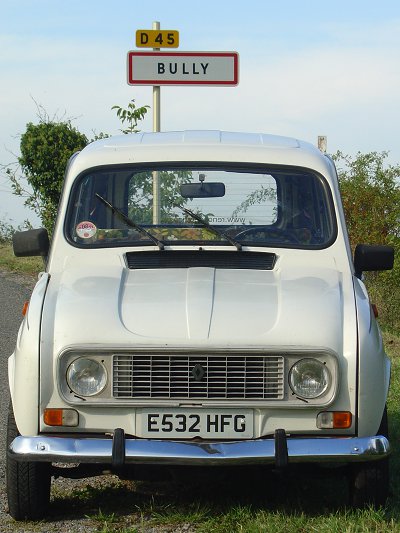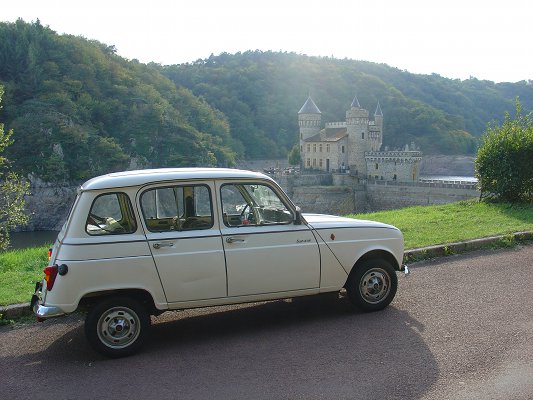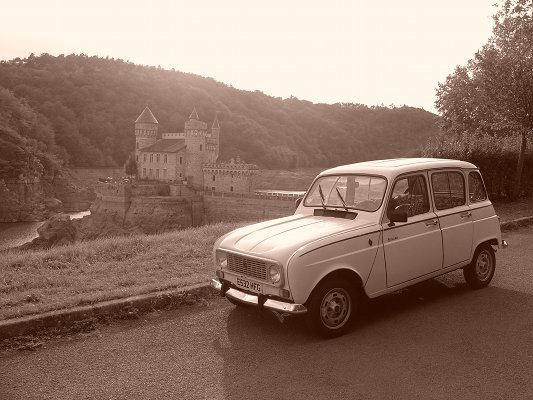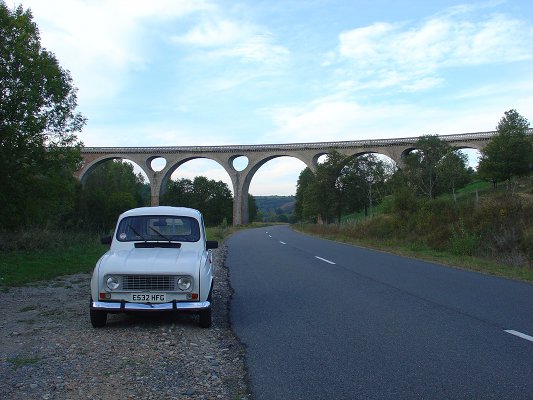
Note: this article will be re-housed in a more reader-friendly location and format at a later date.
Several months have passed since my last photo update here, in part due to my passing some of the spring and summer abroad without the car, which had to sit tight in the UK. But with the Renault 4 approaching its 50th birthday next year, I now reach my 50th entry in my own pics section. Having finally found a longer term lodging in France, in autumn 2010 it was time to revive my stop-start love affair with Lyon and fill up the car with whatever I could cram into it for my emigratory journey there. For the R4, it would be returning to its homeland and I would have my first opportunity to benefit from its left-hand driving position in its native environment. The trip would not be without incident, though I expected nothing less.
For a host of reasons, I decided to try the opposite of my normal tactical approach when sneaking and snaking into the lower reaches of France and the land of Lugdunum. I would travel by night, take the fast autoroute, cut across the centre of Paris and pay all the tolls. The actions of a madman in my own world, though quite the norm for many other Brits who head this way. With a car jam-packed and laden with a good proportion of my personal possessions, negotiating countless brake-inducing roundabouts on French Routes Nationales didn't seem a great plan, and neither did stopping overnight and leaving my worldly goods on show in an insecure hotel car park. I would become Night Driver, in an experience that would somewhat resemble that of the paddle operator in the Atari 2600 video console game of the 1980s, cruising down endless dark, featureless highways listening to the occasional beep beep of passing French motorists, and trying to stay awake.
As ever, there is one small complication in this whole arrangement, which is getting to France in the first place. After checking all the various ferry fares for a fortnight and missing out on the best deal by mere minutes, I plumped for a purchase with P&O going to Calais, in preference over a cheaper deal with Norfolkline which went to my least favourite of the Channel ports, Dunkirk (see entry MP43 from 2009) and which arrived 45 minutes later. But there were plenty of relatively cheap deals to choose from.
An accident on the M25 in which a 4x4 driver had pleasingly ploughed into a tree caused a hold-up on my route to Dover, and it was foot down all the way from thereon. Passing and spurning the final fuel filling station just before the port in order to ensure I reached the P&O check-in prior to the 30-minute advance deadline, I rounded the final bend at 7.14pm in readiness for my 7.45pm sailing. Whilst all the neighbouring operators had several lanes open and traffic passing through swiftly, it was inevitable that P&O would be staffing just one checkpoint, with a long queue moving at a snail's pace.
Though they opened a second gate way too late, by the time I reached the booth the operator informed me that I'd missed my 7.45pm sailing and would be put on the 9.25pm instead. I was directed to lane 41, where I found myself to be just the third in line on a vast empty stretch of tarmac, meaning had I been just three cars ahead I'd have been admitted onto my designated sailing. All around me I could hear tedious middle-England chatterboxes who had, unlike me, actually arrived too late, toasting P&O's goodwill in allowing them to freely take the following ferry, and muttering sentimental sycophancy about how they'd been booking with P&O all their lives because none of the other operators were kind enough to allow free boarding of another sailing if arriving too early or too late.
All very well, for people who arrive late, i.e. NOT ME!
I was mightily peeved at the company's miserly ways and ineffectiveness in not opening enough terminals to deal with vehicles arriving on time. Indeed, I'm sure that they regard their 'flexible' sailing policy as freedom to shuffle customers around if it means money-saving measures at the check-in points. I was now trapped within the checked-in zone and unable to go and get that cheaper British fuel from around the corner, instead having to explore the limited appeal of the horrifically overpriced Moto service point in which half the outlets were already shut.
Things didn't improve once I finally made it on board. Since the arrival (and subsequent sad demise) of SpeedFerries into the cross-Channel ferry market some years earlier, existing pirates had been forced to up their game and refit or renew their vessels. It seemed that P&O, however, had made little such efforts and were still relying on their inherent customer base of ignorant British bores who had never bothered to check out the competition, in order to hold their share of the market. Their Leviathan ship had decor representing the faded glory of a 1972 MFI catalogue, and possessed all the charm of a floating toilet. It could have been adequately run by the French state.
I arrived in France one hour and forty minutes later than intended, close to midnight French time, and about an hour later than I would have arrived had I travelled with Norfolkline for five pounds less. In addition, the first filling station I came to, and which my dashboard needle commanded me to patronize, wanted a whopping €1.54 per litre for its Super Unleaded, as opposed to the £1.11 displayed at the garage I'd passed in Dover. With the Pound valued at 1.2 Euros and French fuel prices at best roughly equivalent to those in the UK, I knew that I'd be getting a bad deal in paying anything over €1.40. Once trapped on the privately run toll roads, the operators sure know how to insultingly milk your every cent when you oblige in filling up at their own service stations.
The journey continued towards Paris, but illegally, since one of the two stick-on headlight beam adapters I had fitted fell off somewhere along the way, just as had happened with the previous set I had bought two years earlier. I would later make the adjustment directly to the bulbs after arriving in Lyon. There was little traffic on the ring road around the capital at 3am, and I carried on down the A6 until dawn, when I took an hour's kip. Thankfully I had pulled into a service station before doing that.
My dozing caused me to completely miss the sunrise over Burgundy that I had stopped to witness, and after another pause for a chewy croissant and the last from my flask, I finally rolled on into Lyon with bloodshot eyes, arriving at my new abode at 11am, some seventeen hours after setting off. That was the easy part over.
The second phase of the operation that I had been dreading, and another of the reasons for travelling overnight, involved trying to single-handedly unload the contents of my car up four flights of a twisty spiral staircase in the heart of historic Vieux Lyon before 11.30am arrived, at which point the automatic morning-long lowering of the bollards, controlling access to the otherwise pedestrianized zone in which I live, terminates. Though I had been issued with a resident's pass before returning to England, I suspected there would be some hiccup in light of my surreally simple obtaining of this card in the face of normally baffling French bureaucracy. My concerns were well founded when I returned to the zone following the requisite half-hour interval between visits, and the card didn't work. Outside of the morning exception period for deliveries, each visit is restricted to half an hour, so having haggled with a crackly voice on the intercom, I was admitted for a second thirty-minute challenge, which necessitated a further dozen round trips up and down the stairs. I almost died, but at least I collapsed on the first floor outside the door to a doctor's surgery, so had I not been able to pick myself up again after a couple of minutes slumped on the steps, I could have tried one last desperate thump on the door.
Perhaps more worrying was the fate of my beloved R4. Whilst waiting for the half-hour to elapse between home visits, I rested the vehicle in a dead-end back street on the Fourvière hillside, next to the city's landmark metallic tower. The following day I returned to the street and found a burnt out Renault 5 parked in the same place where I had stopped. The Lonely Planet guide to France warns in its very first paragraph that the nation's citizens have a penchant for torching cars, but this was too close for comfort. Sadly, there is another idiotic aspect to its citizens' treatment of vehicles, which I'll come to later.
But what about the pictures adorning this page? Shortly after returning to Lyon, I took a couple of friends on an excursion to picture-postcard Pérouges and the many small lakes north-east of Lyon, so this time I instead drove north-west to Roanne, and from there south through the village bearing the name in the top photo. There are plenty of semi-amusing French place names to titillate oneself with, and one presumes 'you get nothing in this town for two in a bed' (non-British readers oblivious to the charms of Central Television in the 1980s aren't expected to understand that).

I wound around the River Loire, crossing dams and aiming casually for one of many châteaux shown in my road atlas, not knowing it would turn out to be such a winner. This stunning castle is Château de la Roche, built atop a rocky outcrop in the 13th century and recently restored. It sometimes appears as an islet when the water level is high up to the wall of the walkway.

Going back to the French and their mistreatment of motors, the pictures above and below show, though not very clearly, some damage to my chrome front bumper, caused by a typical pathetic parking maneouvre witnessed daily on French roads. Bumpers are regarded as their name suggests, as zones with which to barter when moving a vehicle in or out of a space. Indeed, where in Britain such damage might be seen as cause for an insurance claim, here in France the whole body shell of a vehicle is susceptible to being treated as one big crush zone. Take a look at both old and new cars on the French roads and see that not many escape scratches, prangs and often major crumples. I had advised friends before bringing the car to France that this was likely to happen and I was literally counting down the days before the moment arrived. In the end the car survived less than three weeks before getting bruised, and a chrome bumper like this one is neither easy nor cheap to replace. Attempts to knock it back into shape would be futile in view of the same thing likely occurring again within weeks.
These images flatter the car with the bright daylight on the reflective white panels being misjudged by the poor white balance of a typical digital camera, so the various small spots, scrapes and insects betraying its beauty cannot be seen. The bumper damage is worse when seen in close-up, but is still nonetheless relatively minor.
The final photo of this set (below) was taken further east when heading back to Lyon, on a stretch of road between Balbigny and Violay. I'm not sure if this is a viaduct or an aqueduct (the brickwork at the top would suggest the former), but it has an intriguing design and is just one of so many unexpected delights encountered when travelling the back roads of France.

If the car survives further injury then I hope to discover many more secrets around the Rhône region and further afield. Living in the middle of Lyon is great, but the R4 serves as a useful escape pod for getting away from city life every once in a while.
Some additional images from this day's jaunt can be found on the Mystery Cars page (number MC198).
Update 2011-05-23: I retraced this route at the weekend when taking some friends on a tour around the region, and discovered two inaccuracies in what I wrote about the viaduct seen in the photo above. It is no wonder that I failed to locate it previously on Google Earth because I was looking in the wrong place. It is named the Viaduc de Chessieux, and crosses the road running south from Le Château de la Roche alongside the Loire, between the village of Saint-Georges-de-Baroille and the town of Balbigny, just to the north of the new A89. Upon approaching it this time, I spotted cars travelling across it, so I went in search of the access road and took a drive across it myself, as can be seen in the video attached below. The bridge has an 'S' curve and slender construction, and I assume it was originally built to carry trains on a now abandoned rail line. The narrow width would not permit two cars to pass (no, not even two Renault 4s!) so you wouldn't really want to meet anything coming the other way.
Click here for a short clip of Queen Geanine crossing this curvy viaduct.